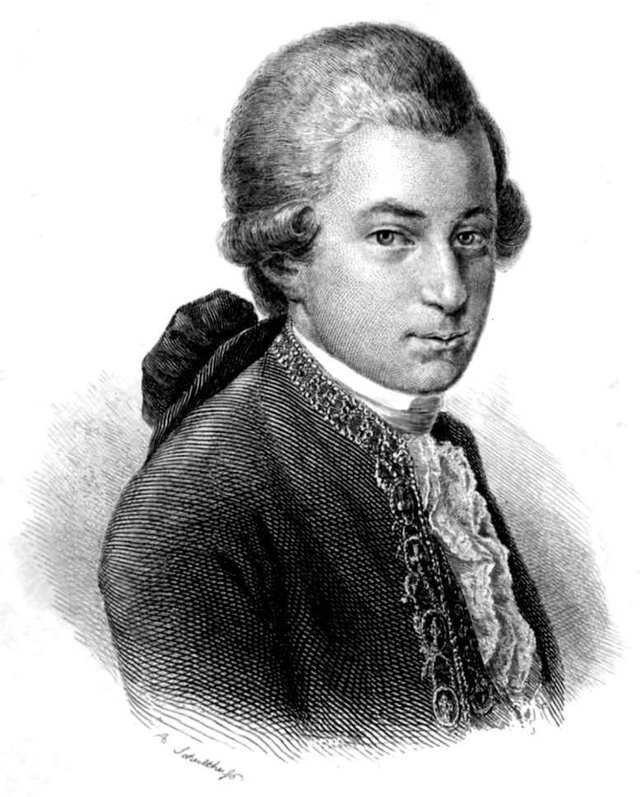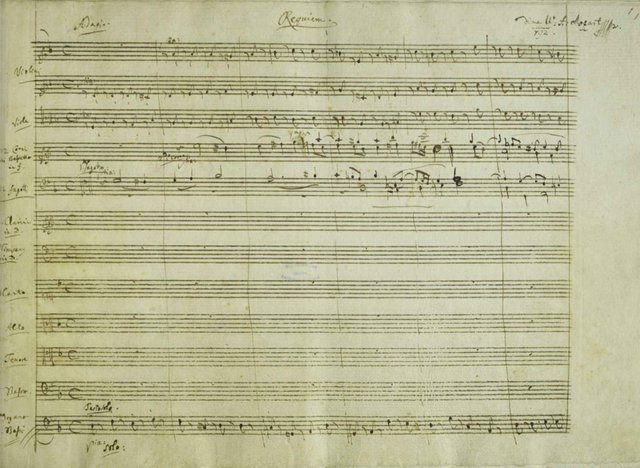Wolfgang Amadeus MOZART – Requiem
Many people know that “Requiem” is the last work of Mozart. But not everyone can imagine how vague, lengthy and confusing the story of this work is. The same can be said about its content.
“Requiem” was ordered to him in the early summer of 1791, six months before the composer's sudden death. Mozart worked swiftly, wrote right away already ready lots, regardless of the number of instruments and voices in the score.

Six months for a musician was an extremely long period for writing a piece. After all, the work on operas took much less time. This was due to the fact that Mozart was overwhelmed with work and constantly postponed the unfinished score of the "Requiem". For example, at the same time, in the summer of 1791, he had to urgently, to the coronation of Leopold II, write the opera "La Clemenza di Tito" and in parallel work on "Die Zauberflöte".
The debut of the first opera took place on September 6, 1791, the second on September 30, 1791. Imagine how fast and with what volume Wolfgang Amadeus had to work, considering that on the same days he also wrote the Masonic Cantata and clarinet concert for his friend Stadler.
Mozart came to grips with "Requiem" only in October 1791 and even stopped accepting students so as not to waste time. The customer was Count Von Walsegg, an amateur musician who was going to publish "Requiem" under his authorship. In those days, this practice was common. In addition, the musicians for such work received decent money.
Von Walsegg wanted to dedicate the mass to his wife, who died in February 1791. He released it in 1793 under his own name, but by that time, after the death of the composer, which caused a great resonance, the authorship could not be hidden.
Mozart wrote only the first section of "Requiem". There are seven liturgical sections in "Requiem", and fourteen parts, this is a full-fledged large symphonic work.
Also, one part (Lacrimosa) of six parts of the third section of Sequenz and the fourth section of Offertorium was written, not completely. For the rest of the pieces, Mozart was fully spelled out vocals and bass. Everything else was in such a state: the fugue orchestration of the second liturgy section, Kyrie, was only scheduled, orchestrations were planned in some parts of the third section (Sequence), plus the Amen fugue, which did not get into the modern «Requiem».
After the composer's death, his wife began to look for someone who could finish the work. She was afraid that the customer would demand money for the fact that Mozart’s work was not completed. The first to whom she turned was Joseph Eybler, a student of Franz Joseph Haydn and Antonio Salieri. Eybler did several orchestrations of the second and third sections and refused, realizing that the burden was not on him.
After that, widow for a long time could not find a talented composer who would like to work on the work. Then she turned to Franz Süssmayr, who was a friend and disciple of Mozart and helped him write the Requiem in the last days, when Mozart composed, without getting out of bed. Mozart discussed with him the plan of the "Requiem", and this was known.

Süssmayr began to write his orchestrations into the maestro's score, which was already heavily spotted with Eybler’s edits, and arranged the entire ill-fated Sequence up to Lacrimosa, which he tried to continue. Then he simply added the remaining three liturgical sections, or rather he made absolutely his own versions based on past conversations with Mozart.
The aforementioned Lacrimosa was written by Mozart for only eight cycles, everything else was written by Süssmayr. This is surprising, since this part is one of the best in the whole work "Requiem". Be that as it may, Süssmayr took the Introitus, completely written by Mozart, attached to it the second, third and fourth section, which was the score, started by Mozart, corrected by Eybler and once again on top corrected by Süssmayr himself.
In conclusion, Franz added his three final parts and gave to the widow. The widow gave everything to the customer and assured that the whole “Requiem” was written by Mozart. It was considered that way until 1838, when Mozart's autograph with the edits of Eybler and Süssmayr and a widow unexpectedly surfaced had to recognize the co-authorship of the latter.
Only in the twentieth century, in 1962, suddenly found a sketchy sketch of the Requiem, written by Mozart with some parts that were very different from the work that we all still listen to under his authorship. It turned out that he planned the Amen after the Lacrimosa part and had very different interpretations of the final sections, intending to quote there the first section, which Süssmayr simply did not hear.
However, experts say that part of Lacrimosa completed perfectly, as if the teacher himself wrote everything. Franz Süssmayr lived only 37 years, and did not know that his Requiem was granted a long life.
Hello @nesmeliy, thank you for sharing this creative work! We just stopped by to say that you've been upvoted by the @creativecrypto magazine. The Creative Crypto is all about art on the blockchain and learning from creatives like you. Looking forward to crossing paths again soon. Steem on!
Thank you nesmeliy! You've just received an upvote of 6% by artturtle!
Learn how I will upvote each and every one of your posts
Please come visit me to see my daily report detailing my current upvote power and how much I'm currently upvoting.
This post was shared in the Curation Collective Discord community for curators, and upvoted and resteemed by the @c-squared community account after manual review.
@c-squared runs a community witness. Please consider using one of your witness votes on us here
Thanx)
Hi nesmeliy,
Visit curiesteem.com or join the Curie Discord community to learn more.
Thank you)
a really interesting post! I have to admit a certain ignorance in terms of music for which I thank you for introducing me to these Mozart songs and all these details from your requiem !! congratulations on your curie vote
Thank you for attention.
Resteemed, your post will appear in the next curation with a SBD share for you!
Your post has been supported and upvoted from the Classical Music community on Steemit as it appears to be of interest to our community. We also support jazz and folk music posts!
If you enjoy our support of the #classical-music community, please consider a small upvote to help grow the support account!
You can find details about us below.
The classical music community at #classical-music and Discord. Follow our community accounts @classical-music and @classical-radio or follow our curation trail (classical-radio) at SteemAuto!
Delegation links: 10SP, 25SP, 50SP, 75SP, 100SP, 150SP, 200SP, 250SP, 500SP, 1000SP